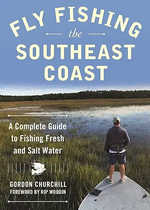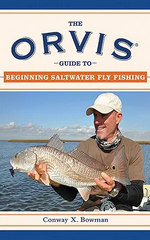Now we are moving from the frying pan into the fire. We are going to talk about flies you really need to have.
But before we do that, we need to talk about leaders, tippets and hook sizes. Ugh, more to remember. But fret not. You’ll get the hang of it fairly quickly. The bottom line is you need the tippet (which is only the final part of your leader- unless you need a wire leader because you expect to catch a fish with teeth that will cut through your tippet, in which case the tippet will be the next to the last part of your leader. Wire will do you no good if it is not up next to the fish, unless you are going after Manta Rays and don’t want the tippet rubbing against the shoulders of the big ray- fortunately, you don’t catch Manta Rays very often)…
So, where were we? Oh yes, tippets and flies. You need the tippet to be small enough to thread it through the hook eye. We have a chart.
But to understand the chart, you need to understand hook sizes. There are two designations for hook size. For reasonably large hook all the way up to huge battleship anchor hooks, we use the /0 scale. The larger the number before the /0, the larger the hook. So, a 1/0 hook will be a regular size hook. You will tie flies on 1/0 hooks for stripers, large bluefish and red drum. Hooks smaller that a 1/0 have only a number and the higher the number the smaller the hook- the opposite of the scale for the /0 hooks where the higher the number, the larger the hook.
For those of us who have lived a long life, it is hard to even see some of the small hooks (24, 26, 28 sizes, for instance) so it is hard as Hades to tie one on, especially with tippets that are the equivalent of 1.2 lb. test line. But those very small hooks and very small tippets catch a lot of fish. I make sure I have a guide with good eyesight for such mundane chores. It’s a pain, I’m sure, but some of them seem to enjoy showing off in front of all us old folks.
Here’s a chart that shows you the tippet number (designated by an X just because that’s the way it is), the flies you can tie on with that size tippet and the approximate pound test at which it will break:
Tippet X Size Size Hooks It Will Fit Approximate lb. test rating
8 X 22, 224, 26 & 28 1.2 lb. test
7 X 18, 20, 22, 24 2.0 lb. test
6 X 16, 18, 29, 22 3.0 lb. test
5 X 14, 16, 18 4.0 lb. test
4 X 12, 14, 16 5 .0 lb test
3 X 6, 8, 19 6.0 ll. test
2 X 4, 6, 8 7.0 lb. test
1 X 2, 4, 6 8.5 lb. test
0 X 1/0, 2, 4 10.0 lb. test
Ordinarily, the tippet is the last 2’-4’ of the leader. So, let’s pause and talk about leaders for a few paragraphs.
Leaders are the part of the equipment that connect the fly to the hook on one end and to fly line on the other end. In order for the leader to have a good presentation (meaning that the fly unrolls from the forward cast properly and lands on the water with a soft PLOP, the leader needs to be tapered. Ideally, the first section of the leader, the one that makes the first connection to the fly line, needs to be close to the diameter of the fly line (more or less). For instance, on my 7-wt. rods on up to 12-wt. I use 40-50 lb. test mono for the first 1/3rd of the leader. Then it starts tapering down fairly quickly until it gets to the tippet.
Here is where you have a choice. The easy way to do it is to go buy tapered leaders that include the tippet. Ordinarily, they will be 9’ or 7 ½’ long and the little packet it comes in will tell you the final tippet size – the X number for the hook end of the tippet. With the advent of loops built into the end of fly lines, most leader companies will have the heavy end of the tapered leader have a loop in it so it is easy to attach with a loop-to-loop arrangement. No knots to tie, no trouble, no fuss, yada yada. What’s not to like? By the way, put the loop in the fly line through the loop in the leader (the loop in the leader goes over the loop in the fly line) and then take the end of the leader and run it through the loop in the fly line and pull to tighten. If you don’t do this, you will have a mess on your hands and you will live in disgrace the rest of your life over the fish you lost because you couldn’t do a loop to loop knot.
Back to our discussion. What’s not to like about buying tapered leaders pre-made?
The price for one thing. Those little tapered leaders can cost you $4-$7 (or more) each! And every time you tie on a new fly you are shortening the leader and having to tie a knot both in the fly’s hook eye and to add more leader/tippet to the end of the shortened tapered leader. That may be unfair but that’s the way life is sometimes.
There is a solution, however. What I do is go to the store and buy 1,000 yard spools of several different size monofilament fishing line (50, 40, 30, 25,20, 16, 12, 10 and sometimes some 6 or 4 lb. test line and I build my own leaders: For a 9’ leader, 3’ of 50, 12” of 40, 12” of 30, 12” of 20, and 3’ of either the 16, 12, or 10 for my tippet. If I am trout fishing, I will go with 3’ of 40 or 30, 12” of 25, 12” or 20, 12” of 12, and 3 ½’ of one of the X size tippet lines.
So, you can buy or build you own leaders. Just know I can buy $150 worth of line and have enough material for at least 100 leaders or more. That would be save me $400-$600 or more. Of course, I have to tie the leaders. But that is simple since I connect each section with a Surgeon’s knot (two Granny Knots) and I never had one fail me. There are better knots (Bimini Twist and Blood Knots) but they are hard to tie, particularly on a mountain stream or in a bouncing boat. The choice is yours.
9’ is not written in the heavens above. It has simply evolved over the years as being a reasonable and workable length in many if not most circumstances. But if you need a very delicate presentation, you might go to a 15’ or longer tippet. In the wind, you might want to reduce the length to have less exposure to the wind. If you are using sinking line but a fly that likes to suspend or even float, go with a shorter leader/tippet (down to 4’, if necessary) to keep the fly from floating several feet above the deep-running line.
9’ is a good compromise. It’s tradition, as Tevye would say.
FLIES
Now, having worn your brain out with all of the above, let’s talk about flies.
For this, we really need to have all you seasoned fly anglers chime in since you have far more experience than I do, particularly since almost all of the mountain trout fishing I do is in a drift boat with a guide who provides all the flies and even ties them on for me. So, I am sort of stupid about dry flies, wet flies, midges, nymphs and the like.
I do know that trout feed on four different types of “flies”: Mayflies, Caddis flies, Stoneflies and Midges as well as Terrestrials (some of which fly) and even minnows, frogs, an occasional mouse, etc.
I have a batch of flies:
Freshwater Trout
Adams Royal Wulff Humpy Caddis flies
Muddler Minnows Blue Wing Olives Stoneflies Terrestrials
Tellicos Tennessee Wulffs. Princes Hare’s Ear Nymphs Copper Johns San Juan Worms Egg Patterns
Smallmouth & Largemouth Bass & Panfish
Clousers Deceivers Bendbacks Wooly Buggers
Poppers Bream Killers
Saltwater Reds, Speckled Trout, Stripers
Black & Purple Toads Clousers Deceivers Bendbacks
Shrimp patterns Merkin crabs Surf candy Poppers
Of course, I have thousands of other flies, some of which I have tried with little success and many more which do little more than occupy space in my many fly boxes.
As for colors on my Clousers and Deceivers, the general rule of thumb is dark in dingy water and at night (yes, at night) and lighter, more colorful flies during the day in clearer water. For some reason, many fish like chartreuse. Most bait fish have a silver underbody and a dark topside. Don’t go too crazy with flash or sparkle- it doesn’t take much. Having eyes never hurt a fly based on baitfish.
If you keep getting follows or bumps but no takes, try a size or two smaller fly.
And check out the paper on Saltwater vs. Freshwater regarding how you set the hook- lift up rod tip in fresh but use a strip set in salt.
Note that I pinch the barb down on all my flies (unless I forget).
So, members and friends of the Cape Fear Flyfishers, let’s hear from you about the 20 flies you have to have. Or make it 30 flies. Or as many as you want. The point is to share your favorites so other members will not be buying blind when they go to a store or look through a catalog.
Also, know that whenever you are fishing, check with a local fly shop for information about what is good in local waters. It has been said to look at the empty bins in fly shops and the bins with the fewest flies in them- these are the flies that people are buying. An interesting tip.
Next up, start thinking about what rod, reel and line you select if you could have only one! Though this sounds like a vision of Hell, let’s give it a shot in coming weeks. But first, the flies. Hit “Reply All” and let us know the flies you have to have with you when you go fishing.
Favorite flies from Cary Davidson
Cary is s Spey guy so check out his words about Spey rods and casting in the paper on Rod selection.
Now to flies. He has simple and definite tastes. You’re not going to break the bank getting Cary’s choices:
-gold ribbed hare’s ear & gold or copper pheasant tail-80% of his trout are caught on these 2 flies;
-2 dry flies light Cahill (because he can see it) and Adams- another 10% each;
-Royal Coachman (out of sheer frustration)- 5%.
These are all famous flies so you should not have any trouble finding them.
Also, take advantage of being a member of Fly Fishers International by going to their webpage. www.flyfishersinternational.org They are working hard to provide a lot of good information about fly fishing online so give them a look.
In addition, special thanks to Steve Moore who is putting these lessons/epistles/papers/ essays/whatever on our web page at capefearff.com



